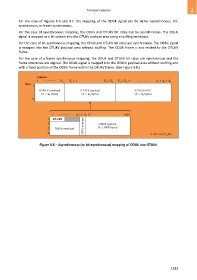Page 1293 - 5G Basics - Core Network Aspects
P. 1293
Transport aspects 2
For the case of Figures II.6 and II.7, the mapping of the ODUk signal can be either asynchronous, bit-
synchronous, or frame synchronous.
For the case of asynchronous mapping, the ODUk and OTUkV bit rates can be asynchronous. The ODUk
signal is mapped as a bit stream into the OTUkV payload area using a stuffing technique.
For the case of bit-synchronous mapping, the ODUk and OTUkV bit rates are synchronous. The ODUk signal
is mapped into the OTUkV payload area without stuffing. The ODUk frame is not related to the OTUkV
frame.
For the case of a frame synchronous mapping, the ODUk and OTUkV bit rates are synchronous and the
frame structures are aligned. The ODUk signal is mapped into the OTUkV payload area without stuffing and
with a fixed position of the ODUk frame within the OTUkV frame. (See Figure II.8.)
Column
1 ....... X 1 X + 1 X + X 2 X + X + 1 ....... X + X + X 3
1
1
1
1
2
2
Row 1
OTUkV overhead OTUkV payload OTUkV FEC
(Y X bytes) 1 (Y X bytes) 2 (Y X bytes)
3
Y
.......
1 14 15 16 17 3824
1 FA OH
2 ODUk payload
3 ODUk overhead OPUk overhead (4 3808 bytes)
4 G.709-Y.1331(12)_FII.8
Figure II.8 Asynchronous (or bit-synchronous) mapping of ODUk into OTUkV
1283

